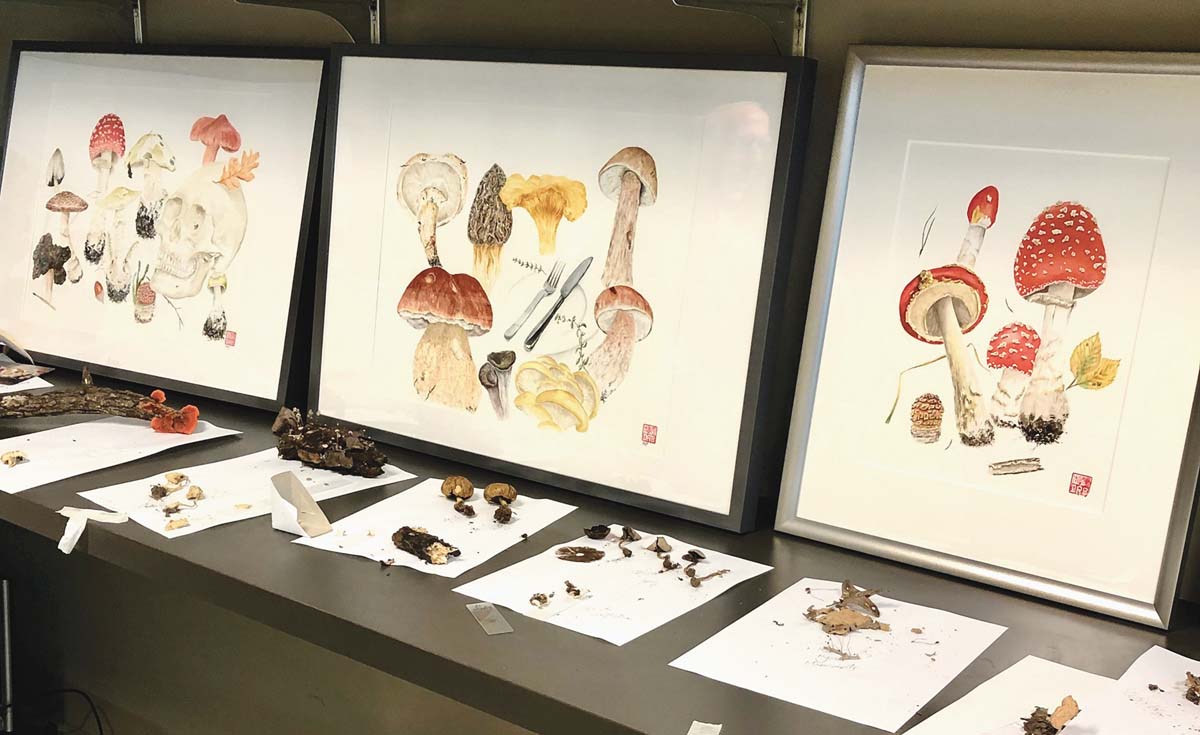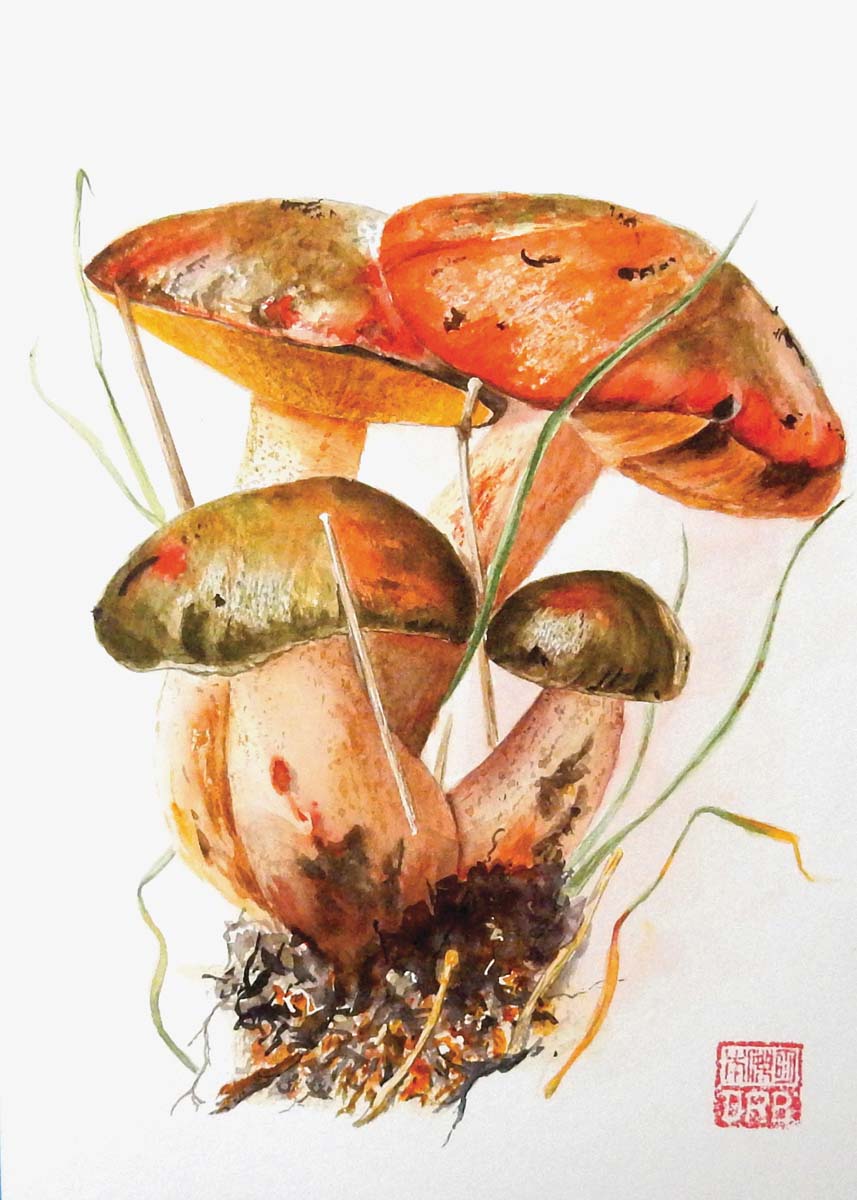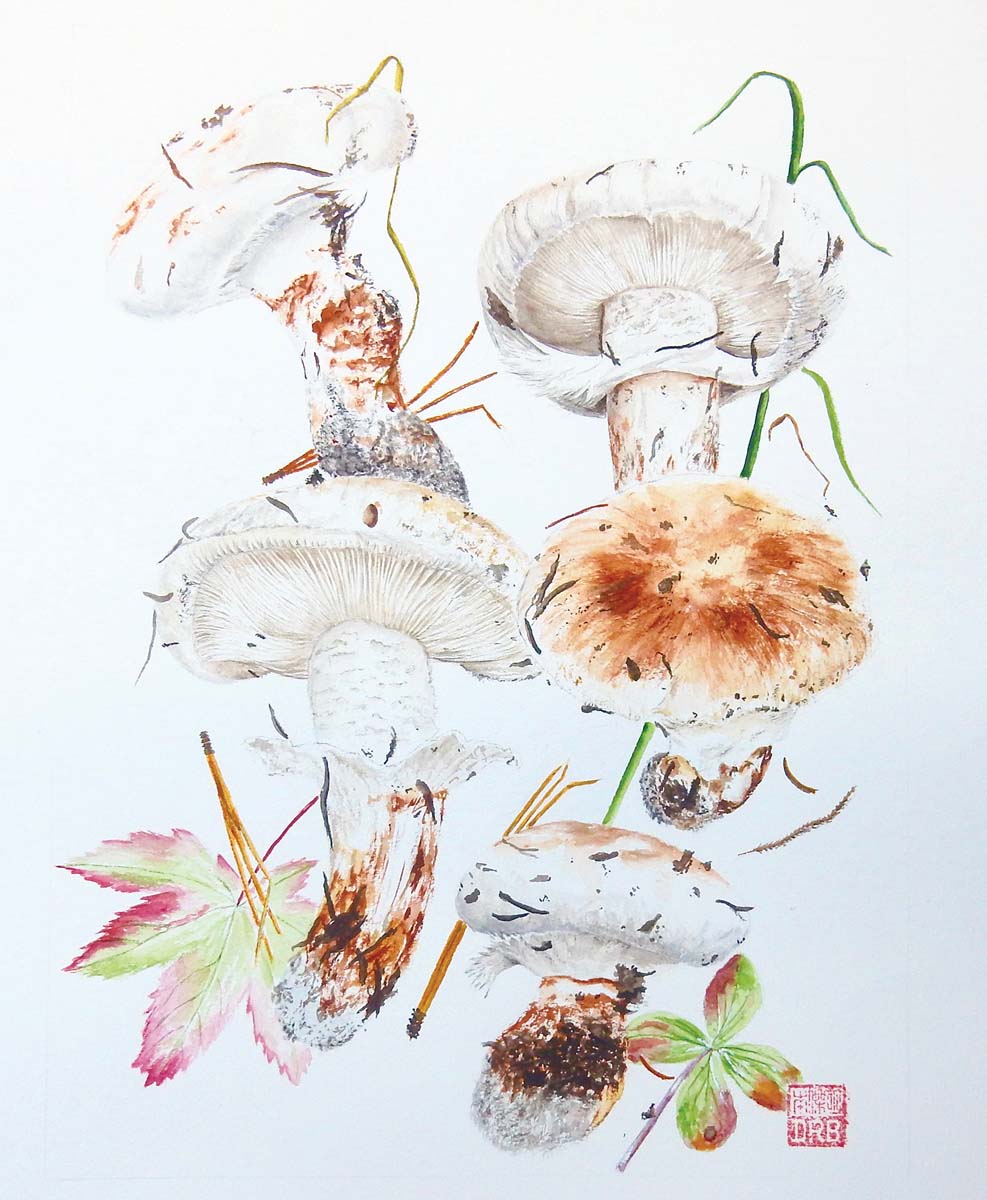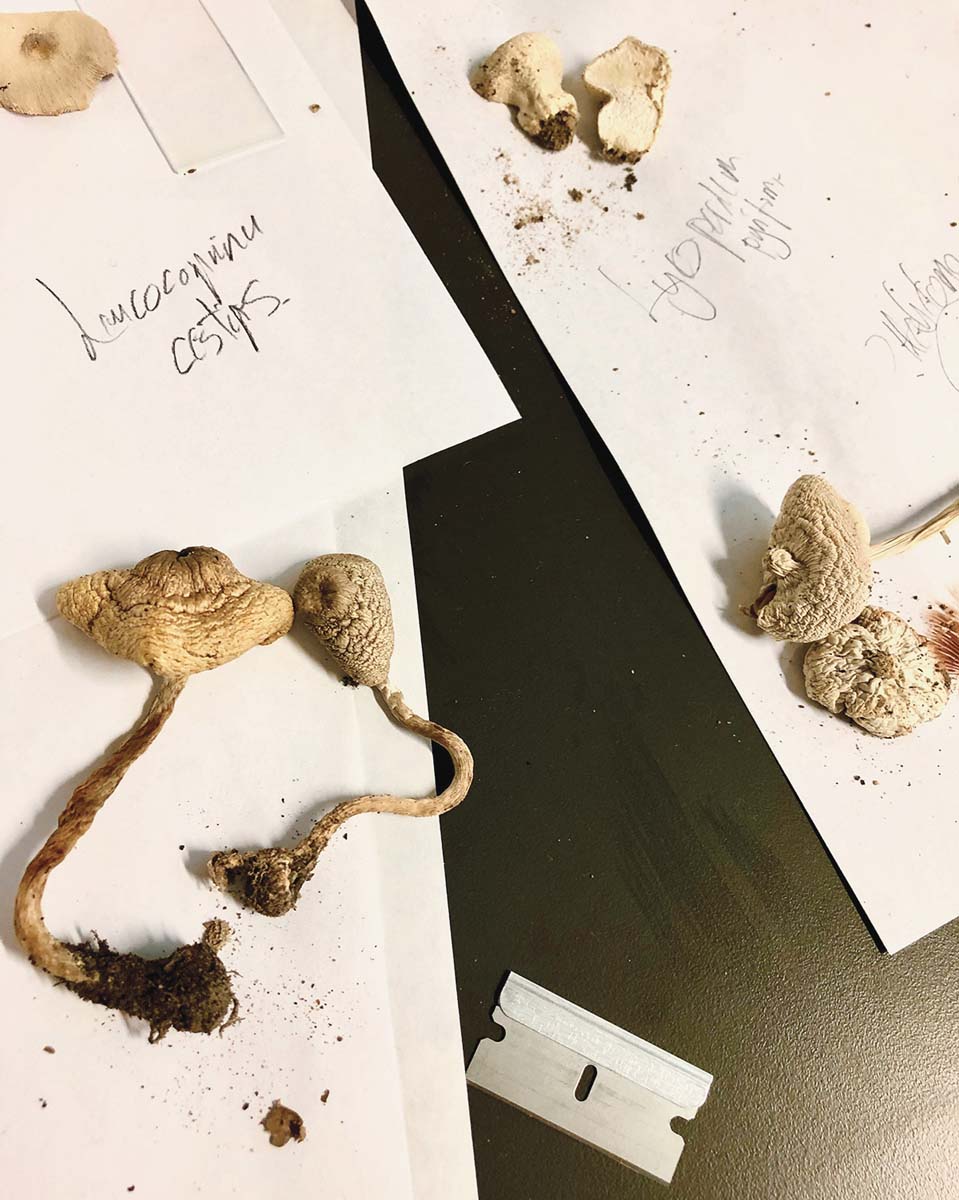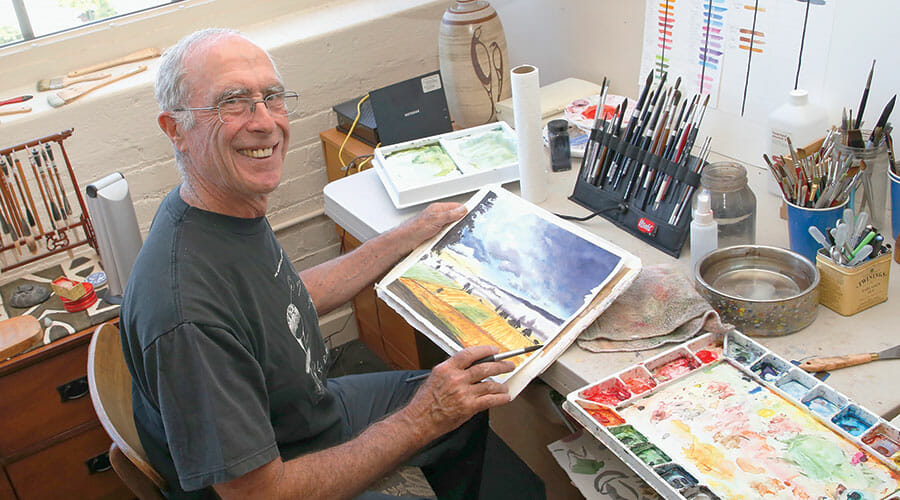
By Babs Rodriguez
Artist Denis Benjamin not only studies mushrooms, he paints them. With a painter’s eye for details — the fine ribs of the cap’s underbelly, the stubby stems — he brings the raw and the uncooked to life on paper. And, yes, they look good enough to eat. Don’t classify him as solely a ’shroom artist, though. Benjamin’s watercolor Pink Bananas: Musa veluntina, shown in the recent “Art in Bloom” exhibit at the Botanical Research Institute of Texas in Fort Worth, proves he also has a deft touch with fruit. He paints flowers, vegetables and animals, too. A retired doctor, Benjamin uses his late-in-life paintbrush skills to capture memories from his travels as well as his foraging expeditions. See his work along with that of five others at “Botanical Art — 6 Ways,” opening this month at BRIT.
A retired doctor has grown his love of mushrooms and botanicals into a second act.
A slime mold expert offices across the hall; a medical anthropologist is at work a few doors down. For pathologist, mycologist, author and artist Denis Benjamin, the arcane specialties of colleagues at the Botanical Research Institute of Texas are part of the appeal of working there. His own office is filled with vignettes of dried mushrooms and watercolor paintings of various specimens that became the subjects of his artful pursuit only a few years ago.
Retired from Cook Children’s Medical Center in 2010, Benjamin’s conjoined passions for mycology and botanical art led him to leap when BRIT’s then director presented an opportunity to curate the fungus collection. Sort through boxes stuffed with materials related to the study of mushrooms? The doctor was in.
Accepting the research associate position led him to muse that a facility with over a million and a half specimens in its herbarium — and a lovely exhibit hall — would be an ideal host for artists with an eye for flora. In 2017, he founded the Botanical Art Collective of North Central Texas, now poised to mount its third exhibition at the institute. His association with the American Society of Botanical Artists was the catalyst for “America’s Flora —Botanical Art Worldwide,” a major exhibit opening at BRIT in September.
Benjamin’s path to Texas was strewn with as many wild cards as wildflowers. Born in South Africa, he trained as a physician in Johannesburg and emigrated to the U.S. in 1970 to complete his residency in pediatric pathology. Thirty years at Seattle Children’s Hospital followed. The Pacific Northwest was a good spot for outdoor enthusiasts Denis and wife Vivien to raise their two sons. “I expected to die happy in Seattle,” he says. A determined recruiter for Cook Children’s changed all that, enticing the doctor in 1999 to visit Fort Worth with his wife. The couple found themselves seduced.
Still, they dithered over pros and cons while flying home. Finally, Benjamin said that if he was able to fill in 20 words on his crossword puzzle, they’d move. Vivien leaned close as he worked. “She was looking over my shoulder and asking, ‘How many do you have? ’ every few minutes. Then, I realized how hard I was working to get answers,” he says. “It became clear: We wanted to make this move.”
The only thing that concerned him was the possibility that his many large glass jars filled with edible mushrooms might not survive the trip. Dried mushrooms intensify in flavor over time, and the Benjamins’ stores are labeled with vintages, like fine wine. The Pacific Northwest had whetted his appetite with its mother lode of edibles (he says the only person he’s ever poisoned is himself). The mushrooms survived the trip and while Texas offered fewer foraging options, there were no regrets about the move. “Coming here was the best thing we did; it reinvigorated me,” Benjamin says.
The couple expected to spend five years in Cowtown before returning to Washington to retire. They stayed 10 years, then sold their ranch in Aledo, did some traveling and built a home on the eastern slope of the Cascades. The climate, the skiing, the hiking and the views were all perfect. But Benjamin began to feel he was in an intellectual desert, and Texas had gotten under his skin. In 2014 the couple moved back and bought a condo at Montgomery Plaza in Fort Worth.
Meanwhile, BRIT had discovered those boxes of mushroom materials that needed cataloging.
And what of the painting that has become more than an avocation? Benjamin had long enjoyed Washington’s mushroom festivals and was frequently tapped as a speaker. Before his move back to Texas he had joined his wife in taking a watercolor class during some downtime at one such event. The focus was mushrooms. The then 69-year-old had never before picked up a paintbrush. He found himself intrigued by the techniques as well as the instructor, renowned Russian botanical artist Alexander “Sasha” Viazmensky. “I found it amazing. I asked Sasha how on earth you paint a white mushroom on white paper. He said, ‘No problem.’ I watched a matsutake appear with a few strokes. It was magic.”
A course at the Gage Academy of Art in Seattle followed. But it was the instruction from the Russian that truly inspired Benjamin as a painter, despite how Viazmensky once characterized the doctor’s abilities. “Sasha said there are two kinds of artists: artists with talent and artists with courage. He said I had courage,” Benjamin says, laughing. “It sounds pejorative, but he’s right. I admired his observation. I don’t have natural ability, but I am willing to work very hard. I was willing to show my stuff before I should have. I was willing to put myself out there.”
Putting himself out there included mounting a show of 30 of his paintings at BRIT in 2016 along with forming an artists circle with an association to the American Society of Botanical Artists that spawned the Botanical Art Collective. When he organized a promotional display for the collective at Fort Worth Community Arts Center one weekend, he discovered it met a need. “People stopped by to whisper their gratitude that I’d given them ‘a home.’ ” Benjamin now maintains an email list of 120 artists from Fort Worth, Denton, Granbury and Waco, and he administers the collective’s Facebook page, where members post new work and share news of exhibition opportunities and info about field trips to area gardens. Too, he continues to organize invitational exhibits at BRIT, including “Botanical Art — 6 Ways,” opening this month and featuring six artists
Asked how he characterizes his own painting style, Benjamin says he still strives to not emulate his mentor’s work. “Sasha is the world’s best mushroom artist. I am still trying to break away from his style.” To challenge himself he shifts up formats and is exploring colored pencils and other media. “Mushrooms are now really easy for me to paint. But, sadly, I don’t think I am ever going to find my own style. I don’t have enough time left.” He has moved on to painting flowers, fruits and vegetables, and is gravitating more toward the sketches and simple paintings of birds and animals that have become his way of keeping travel journals. He says he learned long ago that every painting he makes holds a memory in a way that opens up a broader, almost cinematic image in his mind. “Looking back at each I know exactly where I was, what the sky was doing, how the weather was rolling in.”
We’re grateful he shares the view.

